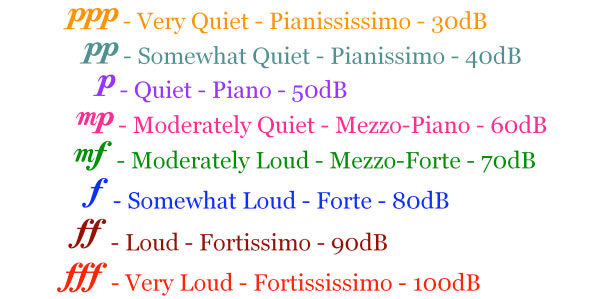Defining Dynamic In Music and Audio
Music is comprised of five major components. Students of music learn these things in private lessons, online courses, and university classrooms. I taught music theory for a number of years and made sure that my students understood the basic building blocks of music. They are: melody, harmony, rhythm, dynamics, and form. I’m going to focus on musical dynamics in this post but will give quick definitions for the other components.
A melody is a linear presentation of individual notes with a given contour and rhythmic structure. They can long (the “Ode to Joy” in Beethoven’s 9th Symphony Finale) or very brief like the opening motive of his 5th Symphony. A melody exists as a horizontal progression through time.
Harmony is the vertical arrangement of 3 or more notes comprising a chord or an interval, which are two notes stacked on top of each other. I took one of those online “test your knowledge” evaluations about music theory (I did get 15 out of 15…no big surprise) and then started reading some of the comments from other complaining about the definition of a chord. One piano teacher in particular insisted that an interval is a chord…that it only takes 2 notes to define a chord or triad (a three note chord)…she’s wrong. She’s wrong because to notes in the interval of a third (either major or minor) can be part of two different triads. It reminded me of the irrational insistence by many that vinyls LPs are the ultimate in music presentation.
Harmony is all about chords and the progression of chords from one to another. And there’s all kinds of harmony…modal, tonal, atonal, quartal and more.
Rhythm is a series or sequence of durations usually related by fractional relationships. Thus we have whole notes, half notes, quarter notes, sixteenth notes and so on. Western music operates with combinations of twos and threes…with many twentieth century compositions extending into 5s, 7s and much more complex durational complexities.
Dynamics in music are relative not absolute. Composers don’t indicated how loud they want a particular section of music to be played. Using Italian terms or abbreviations like (piano, pianissimo, mezzo piano, mezzo forte, forte and fortissimo), they place these and other articulation markings in their scores to give the player of conductor a dynamic contour. Basically, they are saying how much louder or softer one section should be from another. They don’t write down 75 dB SPL (sound pressure level), which is a very specific way of indicating amplitude output from a sound source.
If a selection of music doesn’t possess dynamic variation, it lacks one of the most expressive aspects of music. A singer or instrumental performer spends hundreds of hours practicing dynamic variation. They know the level of subtlety that is required to engage a listen…from the loudest utterances to the quietest sentiment. They all count. The majesty of a superb performance must include the complete range of dynamic levels. And sadly modern commercial recordings don’t.
Some claim the “loudness wars” are over. They are mistaken. Mastering engineers, toolmakers, artists, managers, producers, and record labels continue to maximize the “punch” of every sound on the tracks that they produce because every other track on the radio or on YouTube is doing the same thing. Mastering software has taken over the sensibilities of skilled mastering engineers. When I tell people that I do not mastering or dynamically modify my tracks, they are amazed. “How do you expect to compete with other recordings on DVD-Audio, Blu-ray, or high-resolution downloads?” I simply tell them I’m not competing with anyone…the tracks speak for themselves.
I’m talking about this because it’s important that we have an understanding of how musical dynamics translate into recorded dynamics. I’ll talk about measuring recorded amplitude levels tomorrow.


I really enjoy reading your posts, this one in particular, as I think many listeners don’t appreciate the damage being done by the loudness wars. There is one small, easily corrected, typo: you begin “Music is comprised of four major components…” and then list five “…melody, harmony, rhythm, dynamics, and form.”
I’m looking forward to tomorrow’s post!
All the best,
Bob
Thanks Bob…I usually leave off form when I talk about music components…and then I put it in.
Sadly, in the world of commercial music, I don’t hold out much hope of the dynamic range opening up. In live performance as well as in recording, attitudes seem so firmly based upon being loud: in live venues, in order to utterly drown out the crowd, and on portable audio devices, to compete with the background noise of the streets, gym, aeroplane etc. Those of us who listen via high-quality speakers or decent headphones, in a quiet environment, are comparatively few in number.
“How do you expect to compete with other recordings on DVD-Audio, Blu-ray, or high-resolution downloads?”
It’s as simple: recordings might be produced with Fujitsu 65 GHz 8* bits mono non-anti-alias-filtering ADC + noise-shaped dither + oversampling .
All of these adequately address highly decreased quantizing error level, reduced overall noise, quite seriously increased uncorrelated noise height, perfect dynamic range, very good impulse response {incl. 3D image}, excellent high frequencies, decent square wave test results. This is well, but can be lot better yet.
* Dynamics is independent of bit number; even more so, no higher-end equipment is required for that.
Mark. Keep up the great work getting the message out about what constitutes real high resolution audio. And sadly there’s an amazing amount of confusion as you have clearly pointed out. Putting old recordings in new containers is not High Resolution.
Here’s a very interesting posting by David Pogue that does a listeners test of the Pono, and found it wanting; but all they used was older non high definition recordings. But at lest he was getting close. Certainly someone you need to contact and educate.
See Pogue article about the Pono called The Emporer Has No Clothes on Yahoo Tech